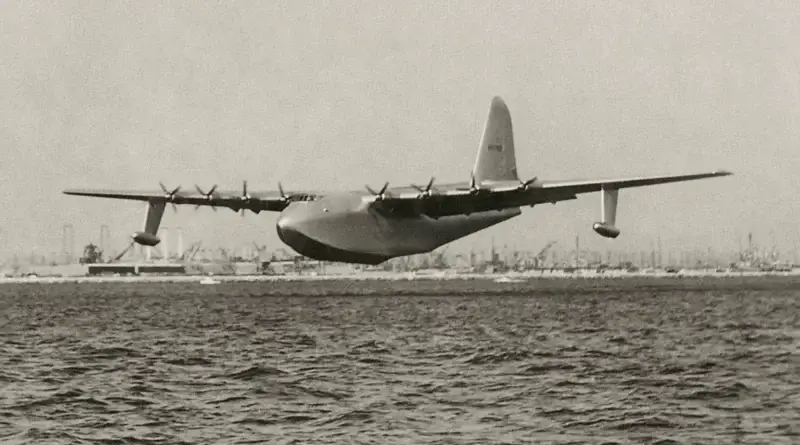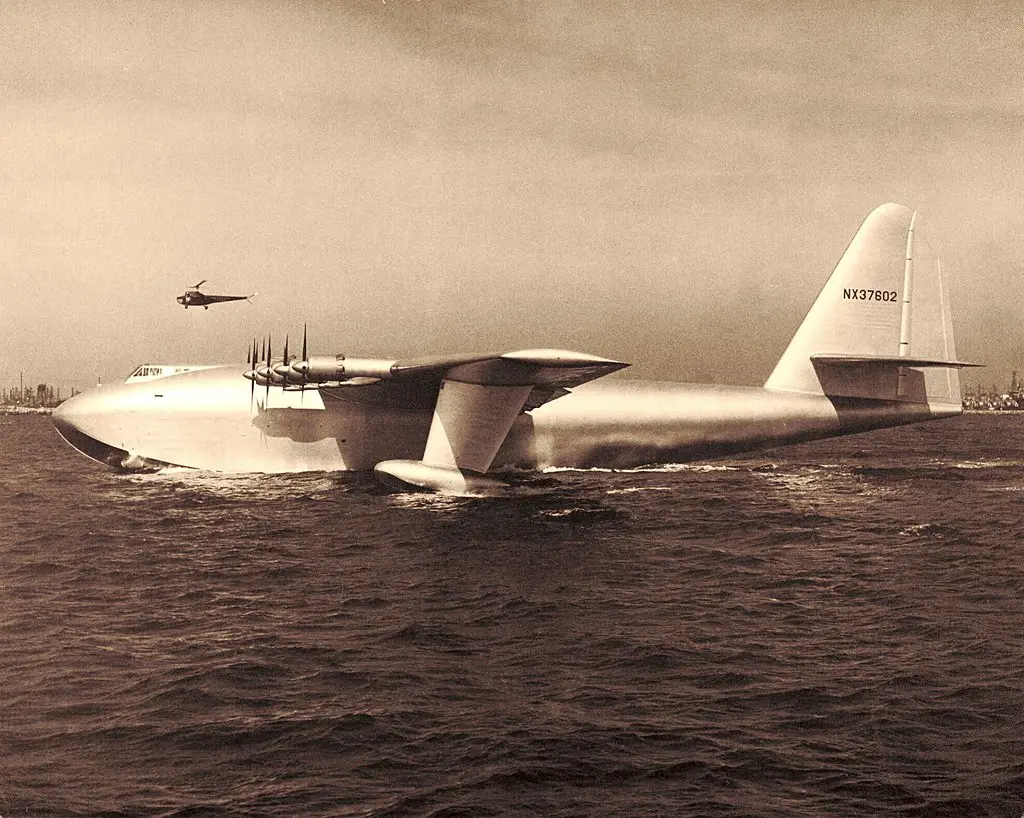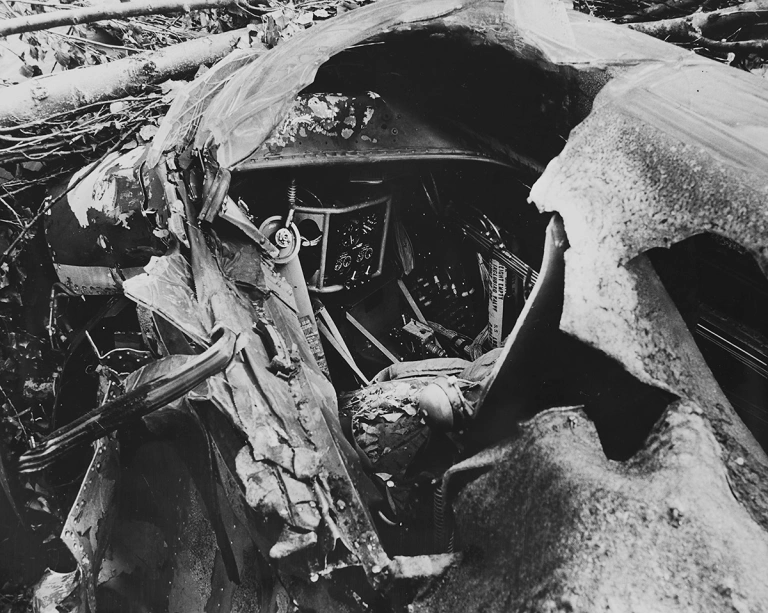Howard Hughes, Why the Spruce Goose?
Howard Hughes, a name that has become synonymous with obsessive compulsive disorder, reclusiveness, the “eccentric billionaire”, was nevertheless, a visionary aviator in his prime.
Before the United States entered World War II, the Texan mogul and film producer had set two new records in the early years of aviation; in September 1935, he broke the world speed record in the H-1 Racer at 352 miles per hour.
In 1938, Hughes set a new record by circumnavigating the world from New York and back in the span of only three days, nineteen hours, and seventeen minutes.
When the war broke out, Hughes accepted a collaboration with shipbuilding entrepreneur Henry Kaiser to build the H-4 Hercules, infamously nicknamed the “Spruce Goose” by pressmen and Senator Owen Brewster from Maine. He also developed the Hughes XF-11 reconnaissance spy plane, which infamously crashed during its maiden test flight on July 7th, 1946.
The projects were far behind schedule, and led to a Senate investigation on Hughes Aircraft Company and all assets that Howard owned. Yes, that also included the films he produced. Many historians have dubbed the project compete failures, but they were in flight for short periods of time.
Howard Hughes
In 1942, the American military requested that all aviation manufacturers look to develop a large air carrier that would be able to carry troops and military equipment; therefore, reducing the amounts of trips each plane would take.
Originally, the project that would become the H-4 Hercules was headed by shipbuilder Henry J. Kaiser, who wanted to develop flying ships to counteract any German U-Boat attacks. The British government experienced massive losses of their cargo ships during the Battle of the Atlantic due to such attacks. Yet, Kaiser was a shipbuilder who needed a man with aviation expertise; that would soon lead him to Howard Hughes.
Both men, while from radically different backgrounds; Kaiser, the son of German immigrants, and Hughes, the heir of a successful Texas lawyer at the zenith of the Texas Tea boom, did secure an $18 million investment to develop the 400,000 pound or 200-ton flying ship. Adjusted for inflation, the cost would be roughly $330 million in 2023 dollars!
1942
Despite securing the investment, certain government restrictions forbade Kaiser and Hughes from using steel or aluminium, or any group that was already in a war effort contract. The challenge? The prototype had to be completed in the span of 24 months, or two years from the fall of 1942, meaning the latest date it would have to be completed by was 1944.
The prototype was notoriously slow because of Howard Hughes’ tendency to perfect each and every minute detail, and his desire for the H-4 to carry 750 troops or two 30-ton M4 Shermans across the Atlantic to Britain. He also took some time off the project to produce the 1943 film The Outlaw, and famously crashed while test flying the Sikorsky S-43 in southern Nevada.
Once 1944 came, Henry Kaiser dissolved the partnership and continued to invest in different ventures in medicine and automobiles; Hughes continued the H-4 project with his chief designer Glenn Odekirk.
Kaiser predicted that the Hercules would become obsolete, as the Boeing C-97 Stratofreighter answered that previous 1942 call by the government. When the Boeing C-97 came in, the need for mass troop and tank shipments were null and void.
$40 Million
Eventually, Howard would soon pump the project with his own capital after the government gave Hughes Aircraft another four million dollars. In the end, Hughes put in $18 million with the government’s $22 million to establish a $40 million budget.
The hull of the behemoth was built with Duramold, a mixture of waterproof resins that was mixed with lightweight materials like plywood. Essentially, the Hercules was a flying birch and fabric machine. The Hercules was unique in its pioneering hydraulically actuated control unit, and a D.C. electrical system that was 120 volts for the controls.
The widest wingspan of its time, the Hercules was measured at 320 feet, 11 inches. It was powered by eight Pratt & Whitney 28-cylinder engines with 17-foot propellers. They clocked in at 24,000 horsepower with intended ranges of 3,000 miles.
Once the project was done in 1947, Hughes was facing legal trouble with the Senate on mishandling funds for the project. During the construction of the Hercules, Hughes was focused on another plane for the war effort, a reconnaissance plane called the Hughes XF-11.
Developing the XF-11
The U.S. Army Air Forces ordered 100 XF-11s from Hughes Aircraft for the war effort, a photo reconnaissance plane with a range of 5,000 miles and a service ceiling of 44,000 feet. This twin engine, all metal monoplane contained a “pair of four-bladed contra-rotating propellers.”
The design led to the XF-11 being not only incredibly complex in mechanics, but in need of more performance quality for the plane to work efficiently. More specifications of the XF-11 included a 101 foot wingspan, a height of 23 feet, and a maximum take off weight at 58,300 pounds.
In May 1945, the project was canceled by the USAAF, but Hughes managed to build two prototypes; one was tested on July 7th, 1946. The second prototype would be evaluated on April 5th 1947 with more conventional propellers to simplify construction. This second prototype had a successful flight, but the newly established U.S. Air Force cited it was unstable at lower speeds so they contracted Boeing to build the RB-50, a less expensive alternative that saw action as late as the 1960s during the Vietnam War.
However, the 1946 maiden flight was marred by catastrophic failure.
July 1946: XF-11 Crash in Los Angeles
A year after the project was scrapped by the U.S. government, Howard Hughes would test the XF-11 in the hopes he could secure a lucrative government contract. At roughly 5:25 pm on July 7th, 1946, Hughes left the Culver City airfield amidst journalists noting the smooth and high altitude the experimental plane took.
By an hour in, the plane immediately yawned to the right as the right engines failed due to hydraulic leaks. The leaks were likely caused by poorly placed or no rings on the engines. The test was only to have been for a thirty minute flight, but was doubled to an hour, to the liking of Hughes.
Hughes attempted to land at the Los Angeles Country Club, but missed it when the plane’s wings crashed on the side of a few houses in the area. A dozen homes were destroyed and the engines exploded in a massive fire.
Hughes was saved by two World War II veterans, a Marine Sgt. William Lloyd Durkin and Army Capt. James Guston. His prognosis was a fifty-fifty chance of survival from the severe internal damage, burns, and scars he endured. These scars would play a role in the reclusion that took hold in his later life.
During the healing process, Howard Hughes had to contend with a Senate hearing on his war projects that were over budgeted and severely behind schedule. During the hearings in 1947, the second XF-11 was tested successfully, and the Hercules took to its maiden flight.
Senate Hearings
After Hughes had recuperated from the 1946 crash, he was called to Washington to testify at the Senate hearings led by Republican Senator from Maine Ralph Owen Brewster. The hearings were determined to ask Hughes what happened to the $40 million in total investment the government placed on Hughes Aircraft for the XF-11 and the “Spruce Goose”, much to the chagrin of Hughes.
It was in these hearings that Hughes famously declared that if the Hercules did not fly, he would pack his things and leave the United States; if it did fly, it would be a validation of Hughes’ word and his commitment to the world of aviation. He also stressed that the Hercules was the height of a five-story building and its wingspan, the biggest in the world, was longer than a football field.
In the end, the Senate hearings concluded that Hughes Aircraft did not defraud the government, and the planes in question were built and tested, although behind schedule and grossly over budgeted. After the hearings ended, the Hercules would finally be taken to the skies.
The “Spruce Goose” Takes Flight
With the Senate hearings still fresh in the American public’s mind, Howard Hughes decided to test the Hercules to prove the wooden titan could fly. On November 2nd, 1947, to prove Brewster and the American public, he had the plane take three taxis in the Long Beach harbour. The first two were uneventful, the plane did not fly the skies. However, it would be the third taxi that stole the hearts and minds of the American public.
The third taxi did take the Hercules to the skies in style, taking the flying boat up 33 feet, flying it for only a mile in less than a minute. It was airborne at the speed of 80 miles per hour. The 2004 film The Aviator captures the tense moments before the plane took flight, with a little Hollywood magic added.
Decades later in 2014, Welsh researchers at Glyndwr University noted that the Hercules had the potential to be airborne for more than a minute, but noted that at low speeds, it was unstable.
Legacies of the Projects
Their research concluded that if the plane’s wings were not level, it would have the risk of tail spinning, causing a catastrophic failure in which the wings would be ripped from the surface. Their research required a £200,000 Merlin flight simulator, with calibrations to closely follow the mechanics and flight quirks of the original Hercules.
The two maiden flights of the H-4 Hercules and the XF-11 were cinematically portrayed in the 2004 Martin Scorsese biopic The Aviator starring Leonardo DiCaprio as Howard Hughes. Both scenes portray the immense effort that Howard did to make these planes fly and the film is highly recommended for any aviation buff or filmgoer alike.
These planes show Howard Hughes as a man who was passionate about aviation, a man who was always seeking perfection, even if it did lead him to a plane crash and Senate hearings after World War II. It’s also important to remember that his OCD played a role in the projects becoming severely behind schedule and over budgeted, leading to the Senate hearings in 1947.
Cold War World
While the H-4 Hercules never saw the skies again, it was kept in running order by Hughes until he died in 1976, twenty-nine years to the day of the second XF-11 prototype’s maiden flight. Since then, the flying beast has been kept in Oregon, and has been recently used by Google as a creative space for its workers.
In recent years some have wondered how the world of aviation would have changed if the Hercules had been picked up by the military. The answer isn’t certain because the U.S. military was cutting down its WWII surplus, and needed smaller planes for transport. There was no place for giants like the Hercules in the Cold War world.
The Hercules, or “Spruce Goose” had the longest wingspan ever built until 2019. At the end of the day, these projects were not failures, but they were signs of potential in the world of aviation. Though OCD and reclusion overcame Howard Hughes in his later years, his inventive mind and drive for perfection should never be forgotten.
Hits: 1












